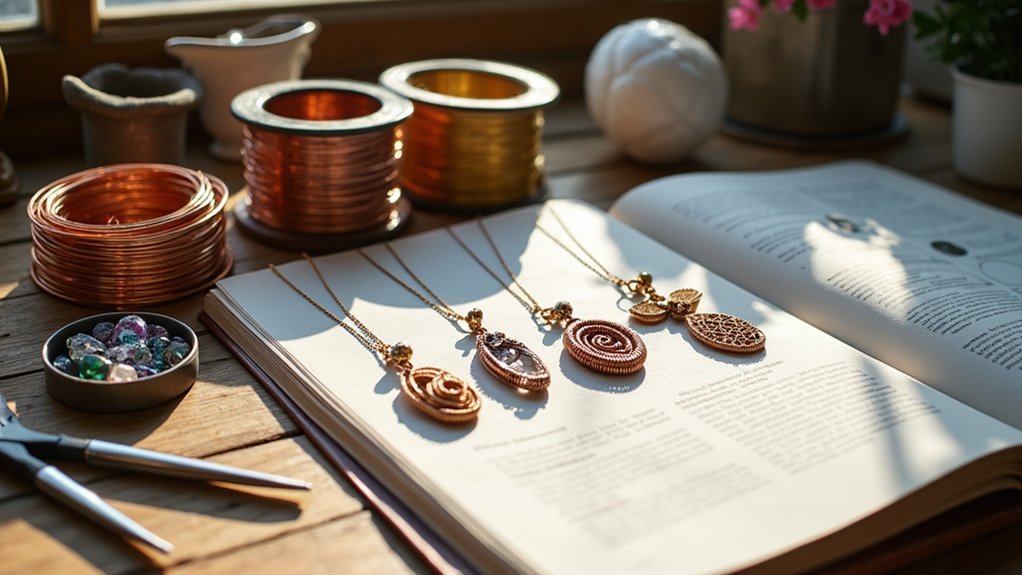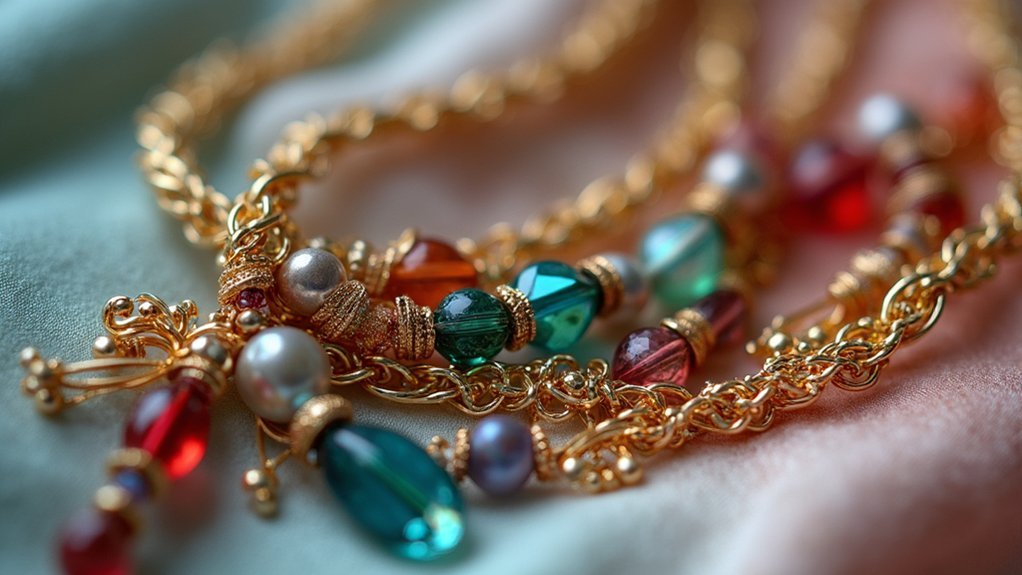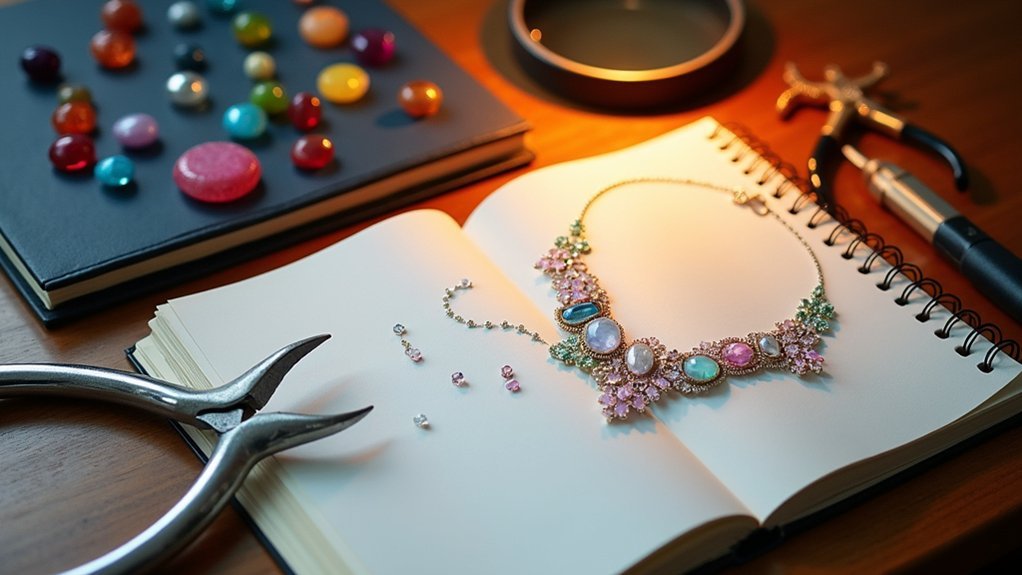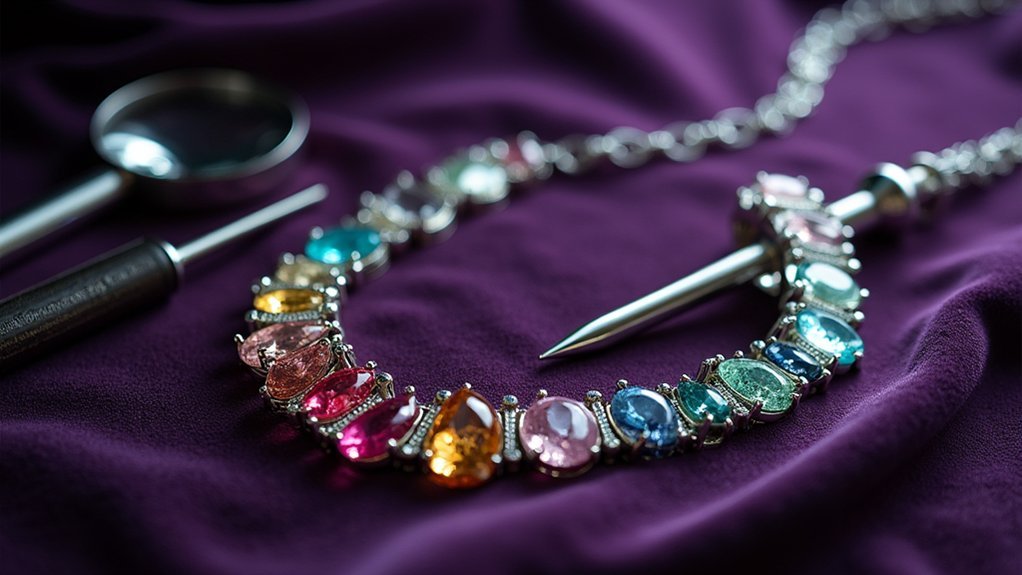Are you ready to transform your wire wrapping skills in 2025? You’ll find clarity and inspiration in these top 10 pattern collections, each offering step-by-step guidance that eliminates guesswork. From Celtic-inspired designs to daily earring projects, these resources provide both technical mastery and creative freedom. Whether you’re just starting out or looking to refine advanced techniques, the right pattern collection can bridge the gap between basic loops and gallery-worthy pieces.
Wire-Wrapped Jewelry Techniques: Tools and Creating Fashionable Jewelry
Whether you’re just starting out or have been crafting jewelry for years, the 176-page illustrated guide “Wire-Wrapped Jewelry Techniques” offers something valuable for every skill level. This Fox Chapel Publishing softcover teaches 30 expert wire-wrapping techniques through 8 stylish projects.
You’ll find clear, large photos accompanying step-by-step instructions that build progressively from simple to complex. The book focuses on shaping wire for drilled beads, primarily using copper or bronze-colored wire for a vintage aesthetic.
Users consistently praise the book’s accessibility and helpfulness, making it an excellent resource to develop your wire-wrapping skills while creating unique pieces that reflect your personal style.
Best For: Jewelry makers of all levels seeking to learn or refine wire-wrapping techniques, particularly those interested in creating vintage-style pieces with copper or bronze wire.
Pros:
- Progressive instruction with clear step-by-step guidance and large photos makes techniques accessible for beginners while building toward more complex skills
- Comprehensive coverage of tools, materials, and 30 expert techniques provides excellent value in a single 176-page resource
- Focuses on adaptable patterns that encourage creativity, allowing crafters to develop their own unique style
Cons:
- Primarily focuses on copper and bronze-colored wire, which may limit those interested in working with silver, gold, or other wire types
- Concentrates mainly on techniques for drilled beads rather than covering a wider variety of wire-wrapping applications
- Some experienced jewelry makers might find the initial projects too basic before reaching the more advanced techniques
Wire & Bead Celtic Jewelry: 35 Quick and Stylish Projects
Jewelry artisans looking for elegant Celtic-inspired designs will find “Wire & Bead Celtic Jewelry” an invaluable addition to their crafting library. With 35 projects reminiscent of the Book of Kells, this collection offers graceful designs for multiple skill levels.
You’ll appreciate the clear instructions that eliminate the need for soldering, using wire wrapping techniques instead. The book begins with essential tool overviews and builds to increasingly advanced projects. While some users note limited step photos, most celebrate the book’s ability to inspire variations on the original designs.
Whether you’re crafting simple pendants or complex bracelets, these quick projects balance efficiency with stunning results.
Best For: Wire jewelry enthusiasts of all skill levels seeking elegant Celtic-inspired designs that can be created without soldering techniques.
Pros:
- Features 35 quick and stylish projects with clear instructions that range from beginner to advanced difficulty
- Includes comprehensive information on necessary tools, wire gauges, and basic techniques to get started
- Beautiful visual designs reminiscent of the Book of Kells that inspire creative variations
Cons:
- Some steps lack sufficient photographs to guide beginners through more complex techniques
- May require supplementary resources for additional jig patterns or advanced techniques
- Some users reported concerns about the physical quality of the book itself
Handcrafted Wire Findings: Techniques for Custom Jewelry Components
The art of creating custom jewelry components elevates your designs to professional quality while saving you money. Denise Peck and Jane Dickerson’s book walks you through creating personalized findings that maintain design continuity throughout your pieces.
You’ll master essential techniques like wire gauge selection, flush cutting, hammering, and using a micro torch. The book features detailed projects for ear wires, links, connectors, and various clasps—all with clear photographs and step-by-step instructions.
Perfect for beginners yet valuable for experienced wire workers, this extensive guide includes practical tips and insider secrets typically learned only in workshops.
Best For: Jewelry makers with basic wire-working skills who want to create custom findings that match their designs while saving money and ensuring consistent style throughout their pieces.
Pros:
- Provides clear, step-by-step instructions with high-quality photographs for creating various findings including ear wires, clasps, and connectors
- Includes valuable techniques like using a micro torch, wire hammering, and fusing that are typically learned only in workshops
- Offers a comprehensive introduction to materials, tools, and wire basics while repeating key instructions throughout for accessibility
Cons:
- Some projects require specialized equipment like a micro torch which beginners might not have
- Limited alternative techniques for those who prefer not to use twisted wire methods
- May contain redundant information for experienced jewelry makers who already understand basic wire-working principles
A Year in Earrings: 365 Designs and Variations
For creative spirits seeking a daily dose of jewelry-making inspiration, “A Year in Earrings: 365 Designs and Variations” delivers exactly what its title promises—a unique earring design for every day of the year.
You’ll need minimal equipment: just jewelry pliers, wire, and decorative components to get started. What makes this collection stand out is its accessibility for all skill levels—even 16-year-olds have successfully created multiple designs from its pages.
The clear instructions, coupled with online resource recommendations, make this book invaluable whether you’re a beginner or experienced crafter. You’ll find yourself bookmarking favorites and experimenting with shapes, colors, and materials as you develop your personal style.
Best For: Jewelry-making enthusiasts of all skill levels who want daily inspiration for creating unique, fashionable earrings with minimal equipment and maximum creativity.
Pros:
- Offers 365 distinct designs providing year-round inspiration for both beginners and experienced crafters
- Requires minimal equipment and includes helpful resources for finding components online
- Features clear, easy-to-follow instructions that even teenage beginners can successfully use
Cons:
- May overwhelm complete beginners with the sheer number of design options
- Some designs might require specialized components that aren’t readily available locally
- Limited to earring designs only, not covering other jewelry types for those wanting broader jewelry-making guidance
The Missing Link: From Basic to Beautiful Wirework Jewelry
Mastering wire jewelry techniques becomes approachable with Cindy Wimmer’s “The Missing Link: From Basic to Beautiful Wirework Jewelry.” This extensive guide stands out for craftspeople who want to progress beyond basic wirework, offering 30 distinct links organized by difficulty level and 20 practical projects to apply these techniques.
You’ll appreciate the thorough instructions and detailed photographs that make complex techniques feel like having the author guide you personally. The book covers essential tools, wire types, and finishing methods while showcasing versatile designs that range from sleek to bold. These links aren’t limited to jewelry—they’re adaptable for accessories, garments, and mixed-media crafts.
Best For: Jewelry makers and craft enthusiasts of all skill levels who want to expand their wirework techniques beyond the basics and create unique, professional-looking designs.
Pros:
- Exceptionally clear instructions and detailed photographs that make complex wire techniques accessible to both beginners and experienced crafters
- Versatile content with 30 distinct wire links organized by difficulty level and 20 practical projects that showcase real-world applications
- Techniques extend beyond jewelry making to other crafts like accessories, garment closures, and mixed-media projects, increasing the book’s value
Cons:
- May be overwhelming for absolute beginners with no prior wirework experience
- Some readers might desire more projects relative to the number of link techniques taught
- Limited coverage of more advanced wire sculpture techniques that go beyond link-based designs
Easy & Elegant Beaded Copper Jewelry Guide (Fox Chapel Publishing)
Aspiring jewelry makers seeking an extensive wire-wrapping guide will find “Easy & Elegant Beaded Copper Jewelry” from Fox Chapel Publishing particularly valuable. This thorough reference covers techniques for copper, sterling silver, and gold-filled wire.
You’ll master 346 different wire links through step-by-step instructions and crystal-clear photographs. The methodical organization walks you through basic tools, bent-wire links, chain connections, and hook-and-eye sets before advancing to complete projects.
Whether you’re a beginner following the detailed project instructions or an experienced crafter designing your own pieces, this book provides the perfect foundation for creating unique, elegant jewelry with confidence.
Best For: Beginner to intermediate jewelry makers who want to learn comprehensive wire-wrapping techniques for creating copper, sterling silver, or gold-filled jewelry with a methodical approach.
Pros:
- Contains an extensive collection of 346 wire links with step-by-step instructions and clear photographs, making techniques accessible for all skill levels
- Methodically organized structure allows readers to build skills progressively from basic tools to complete projects
- Balances guided projects with creative freedom, encouraging users to either follow detailed instructions or design their own unique pieces
Cons:
- Primarily focuses on copper wire, which may limit those specifically interested in other materials
- May be overwhelming for absolute beginners due to the comprehensive nature and volume of techniques presented
- Some readers might prefer more advanced projects beyond the basics covered in the book
Wirework: An Illustrated Guide to the Art of Wire Wrapping
Dale Cougar Armstrong’s extensive guide stands out as an invaluable resource for intermediate jewelry makers who’ve mastered basic techniques and are ready to elevate their craft. The book excels with precise measurements, high-quality photography, and detailed illustrations that demonstrate advanced wire wrapping methods.
You’ll appreciate the step-by-step instructions for creating bracelets, rings, and earrings, complete with specifics on wire gauge and hardness. While not for absolute beginners, teens and adults with some experience will find it perfect for skill development.
Though the accompanying DVD receives mixed reviews, the book itself delivers exceptional content that’ll help you create professional-looking pieces.
Best For: Intermediate jewelry makers who have already mastered basic techniques and are looking to advance their wire wrapping skills with detailed projects and professional guidance.
Pros:
- Provides clear, detailed instructions with precise measurements and high-quality photography that illustrates advanced wire wrapping techniques
- Contains comprehensive information on wire gauge, hardness, and shaping methods that help create professional-looking jewelry pieces
- Features an Inspiration Gallery that motivates readers to develop their own unique designs after mastering the taught techniques
Cons:
- Not suitable for absolute beginners as it assumes prior knowledge of basic jewelry-making tools and techniques
- The accompanying DVD has received mixed reviews, with some users reporting playback issues and finding the instruction style condescending
- Some projects require significant practice to master, which might frustrate those expecting quick results
200 Beading Tips, Techniques & Trade Secrets
The “200 Beading Tips, Techniques & Trade Secrets” stands as an essential companion for wire wrapping enthusiasts who want to elevate their jewelry-making skills. This all-encompassing resource serves both beginners and intermediate beaders with well-organized fundamentals and advanced techniques.
You’ll appreciate the clear explanations accompanied by step-by-step diagrams and photos, including correction images that help you identify and fix mistakes. With nearly half the content devoted to bead weaving, you’ll master stitches like Right Angle Weave and Peyote while expressing your creativity through customizable projects.
Each technique includes practical applications with specific bead counts and substitution options, making this beading bible your go-to reference for creating unique jewelry pieces.
Best For: Jewelry makers and crafters looking to expand their beading skills, from complete beginners to intermediate-level artisans seeking to refine their techniques and learn new stitches.
Pros:
- Comprehensive coverage of beading techniques with clear step-by-step instructions and helpful visuals including correction photos
- Extensive focus on bead weaving (nearly half the book) with detailed instructions for popular stitches like Right Angle Weave and Peyote
- Includes practical projects with specific bead counts and encourages creativity through color substitutions and technique combinations
Cons:
- May be overwhelming for absolute beginners due to the extensive amount of information presented
- The heavy emphasis on bead weaving may disappoint those primarily interested in other beading techniques
- Some readers might prefer more advanced projects beyond the intermediate level covered in the book
Stitching with Two-Hole Shaped Beads
Beaders at any skill level will find tremendous value in this extensive guide to two-hole shaped bead stitching. The clear instructions and versatile patterns progress from simple to complex designs, making it accessible whether you’re just starting or advancing your skills.
You’ll appreciate the excellent diagrams accompanying each pattern, though some experienced beaders suggest writing out bead sequences for clarity. The book shines in its exploration of various two-hole bead types including SuperDuos, Bricks, and Tilas.
One drawback: patterns list bead counts without weights, which complicates online purchasing. Despite this, the well-organized content and difficulty-level categorization make this a must-have for your beading library.
Best For: Beaders of all skill levels who want to explore two-hole shaped bead stitching, with particular value for those interested in working with SuperDuos, Bricks, and Tilas.
Pros:
- Provides clear instructions with excellent diagrams that progress from simple to complex designs
- Covers a wide variety of two-hole bead types, encouraging creativity and experimentation
- Well-organized content with patterns categorized by difficulty level, making it accessible for beginners and experienced beaders alike
Cons:
- Lacks bead weight listings alongside counts, making online purchasing of materials difficult
- Some patterns require significant concentration and may challenge beginners
- Some users recommend writing out bead sequences separately to simplify the instructions
JPF Crochet Club Jewelry Collection
Crafters seeking both clear guidance and creative flexibility will find the JPF Crochet Club Jewelry Collection an outstanding resource. This well-received collection offers original designs with instructions that are easy to follow, even without step-by-step photos.
You’ll appreciate how the patterns incorporate beads and yarn around hard plastic items, though some users prefer creating softer pieces for anxiety relief. While beginners might need help with abbreviations, the value for price is exceptional.
Many crafters use this collection as inspiration, mixing elements to create unique jewelry. With various crochet cotton colors available, you can personalize projects according to your preference.
Best For: Intermediate crocheters looking to expand their skills into jewelry-making with clear patterns that can be customized to personal preferences.
Pros:
- Clear, easy-to-follow instructions that provide value for the price
- Original designs that incorporate beads and various materials for creative jewelry pieces
- Flexible patterns that can be used as inspiration for mixing elements to create unique pieces
Cons:
- Lacks step-by-step photos for each instruction, making it potentially challenging for complete beginners
- Some users found the crochet abbreviations unclear without prior knowledge
- Primarily focuses on hard plastic items rather than including softer material options for those seeking anxiety relief
Factors to Consider When Choosing Wire Wrapping Pattern Collections With Clear Instructions
When you’re selecting wire wrapping pattern collections, you’ll want to verify the instructions match your skill level and contain high-quality photos that clearly demonstrate techniques. Look for patterns with detailed step-by-step explanations that leave no room for confusion about wire placement or wrapping techniques. A thorough list of required tools and materials will save you time and frustration before you begin your project.
Subheading Discussion Points for “Factors to Consider When Choosing Wire Wrapping Pattern Collections With Clear Instructions”
Why do some wire wrapping enthusiasts struggle while others flourish? The difference often lies in their learning resources. When selecting pattern collections, prioritize instructional clarity—look for step-by-step guidance that breaks complex techniques into manageable parts.
You’ll want collections offering progressive skill development, starting with beginner-friendly projects before advancing to more intricate designs. Don’t underestimate the power of visual aids; detailed photographs help you visualize proper technique execution.
Ensure your chosen resource covers foundational skills and essential tools, creating a solid base for future creativity. Finally, consult user reviews to gauge real-world effectiveness—experienced crafters can tell you which books truly deliver on their promises of clarity and inspiration.
With these considerations in mind, you’ll find collections that transform frustration into creative fulfillment.
Skill Level Compatibility
Matching your skill level to your chosen wire wrapping pattern collection dramatically impacts your learning journey and creative satisfaction. When browsing collections, look for clear indications of whether they’re designed for beginners or experienced crafters. Beginner-friendly collections typically include foundational techniques with thorough explanations, while advanced ones may assume familiarity with basic skills.
The ideal collection offers a progression of projects that build in complexity, allowing you to develop confidence through increasingly challenging designs. You’ll benefit most from instructions that align with your current abilities while gently pushing your boundaries. Many quality collections include customization options that let you adapt patterns to your comfort level. Don’t overlook collections with troubleshooting tips and common mistake warnings—these features can greatly reduce frustration as you develop your wire wrapping expertise.
Photo Quality Matters
Visual excellence in pattern instructions serves as the cornerstone of successful wire wrapping projects. When selecting pattern collections, prioritize those with high-resolution photographs that clearly demonstrate techniques from multiple angles. You’ll find your learning curve greatly reduced when images showcase both close-up details and complete project views.
Look for collections that include step-by-step visual breakdowns of complex techniques, allowing you to follow along without confusion. The best resources also feature “correction photos” that highlight common mistakes, helping you troubleshoot your work before problems become permanent.
Quality visuals complement written instructions, making abstract concepts concrete even for beginners tackling intricate designs. Your success with wire wrapping directly correlates to how well you can visualize each step—make photo quality a non-negotiable factor in your pattern collection choices.
Step-by-Step Explanation Clarity
Clear instructions serve as the backbone of any worthwhile wire wrapping pattern collection. When evaluating pattern books for your 2025 projects, look for explanations that break each technique into manageable steps with precise language that eliminates guesswork.
The best collections pair detailed written directions with high-quality visuals that illustrate hand positions, wire manipulations, and critical angles. Check that materials and tools are thoroughly listed before each project, preventing frustrating mid-project interruptions.
Seek out collections that thoughtfully progress from simple to complex designs, allowing you to build skills incrementally. Remember that clear instructions don’t just prevent mistakes—they empower your creativity by establishing a solid technical foundation. Many crafters report that well-explained patterns ultimately gave them confidence to develop their own unique designs and techniques.
Tool Requirements Listed
When you invest in a wire wrapping pattern collection, thorough tool lists serve as your project roadmap to success. Look for collections that clearly outline all necessary tools before you begin, preventing mid-project frustrations when you discover you’re missing a vital implement.
Quality collections specify wire gauges and essential tools like pliers, cutters, and hammers for each project. The best resources include sections on proper tool usage with tips for beginners, making complex techniques more approachable.
Pay attention to collections that organize projects by complexity level, indicating which specialized tools are required for each difficulty tier. This organization helps you efficiently plan your crafting journey and gradually build your toolkit as you progress from simple designs to more intricate pieces.
Material Specifications Detail
Successful wire wrapping projects depend heavily on proper material selection outlined in your pattern collection. Look for collections that clearly specify wire types—copper, bronze, or sterling silver—as each material affects your piece’s appearance and longevity.
Pay close attention to recommended wire gauges and hardness levels (soft, dead soft, or half-hard), as these determine your creation’s strength, flexibility, and ability to maintain its shape after manipulation. Quality pattern collections will include precise wire length requirements, helping you purchase materials accurately and minimize waste.
Additionally, ascertain your chosen patterns detail which beads and components work best with specified wire types. This compatibility information prevents frustrating mismatches during your crafting process. Well-documented material specifications make the difference between professional-looking jewelry and disappointing results.
Project Variety Range
Diverse project options within your wire wrapping pattern collection will greatly enhance your creative journey and skill development. Look for collections that balance simple projects for building confidence with complex designs that challenge your skills as you progress.
The best collections offer a range of jewelry types—earrings, necklaces, bracelets, and custom findings—giving you versatility in your crafting practice. You’ll want both quick projects for immediate satisfaction and intricate designs for deeper engagement when you have more time.
Prioritize patterns that encourage customization, allowing you to adapt designs to your personal style. Collections featuring distinct techniques for each project will broaden your wire wrapping expertise more effectively than those using repetitive methods. This variety keeps your crafting experience fresh and continuously educational.
Technique Building Progression
Beyond project variety, the instructional flow of a pattern collection shapes your wire wrapping journey. Look for books that introduce foundational techniques first before gradually advancing to complex methods, creating a smooth learning curve for your development.
The best collections organize projects by difficulty levels, allowing you to progressively build skills while having room to grow. You’ll make faster progress with resources that pair clear, step-by-step instructions with visual demonstrations of each technique.
Effective pattern books repeatedly reinforce key skills throughout different projects, helping cement your foundational knowledge. They’ll also encourage adaptation of existing patterns, which nurtures your creativity while you master essential techniques. This balance of structure and creative freedom helps you develop your unique wire wrapping style while building technical proficiency.
Frequently Asked Questions
Can I Use Colored Wires for Traditional Wire Wrapping Designs?
Yes, you can definitely use colored wires for traditional wire wrapping designs. They’ll add a vibrant, personal touch to your creations while still allowing you to follow classical techniques and patterns. Experiment with different colors!
How Do I Prevent Wire Tarnishing on Finished Jewelry Pieces?
To prevent wire tarnishing, you’ll need to seal your jewelry with clear nail polish, Renaissance wax, or jewelry sealant. Store pieces in airtight containers with anti-tarnish strips and keep them away from moisture.
Which Gauge Wire Works Best for Beginners?
For beginners, you’ll find 20-22 gauge wire most forgiving. It’s sturdy enough not to break easily yet pliable enough to manipulate comfortably. Start with copper or aluminum before investing in precious metals.
Are There Waterproof Wire Wrapping Techniques for Beach Wear?
Yes, you’ll want to use coated copper or stainless steel wire and seal your wraps with clear nail polish or jewelry-grade resin. These waterproof methods guarantee your beach jewelry stays beautiful despite salt water exposure.
Can Wire Wrapped Jewelry Be Resized After Completion?
Yes, you can resize wire wrapped jewelry after completion. Small adjustments are possible by carefully bending the wire framework, adding extension chains, or removing sections. However, major resizing might compromise the original design’s integrity.





Leave a Reply